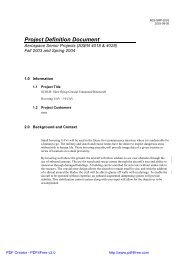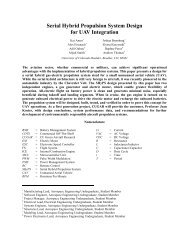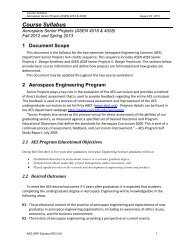PFR - Aerospace Engineering Sciences Senior Design Projects ...
PFR - Aerospace Engineering Sciences Senior Design Projects ...
PFR - Aerospace Engineering Sciences Senior Design Projects ...
You also want an ePaper? Increase the reach of your titles
YUMPU automatically turns print PDFs into web optimized ePapers that Google loves.
Project Final Report – CUDBF April 30 th , 2009<br />
ASEN 4028: <strong>Aerospace</strong> <strong>Senior</strong> <strong>Projects</strong><br />
8.0 Mechanical <strong>Design</strong> Elements<br />
Author: Shivali Bidaiah<br />
Co-Author: Ben Kemper, Mark Findley<br />
8.1 Aerodynamics Mechanical <strong>Design</strong> Elements<br />
8.1.1 Aircraft Geometry<br />
The analysis that was done on the effect of static margin with varying sweep angles and varying<br />
taper was used to determine the optimal geometry given the requirement for the aircraft to fit in<br />
the box. In order to have the most room along the wing for control surfaces, the span was chosen<br />
to be 68 inches. This satisfies the minimum wing span requirement of 60 inches. Figure 33<br />
shows the aircraft geometry:<br />
Figure 33: Aircraft Geometry<br />
The analysis done showed that the static margin increased as the sweep angle increased between<br />
20 and 25 degrees. The best possible configuration that meets the requirement to fit in a 4’x2’x2’<br />
box is a leading edge sweep angle of 23 degrees and a taper ratio of 0.5.<br />
Because this project involves flight missions with asymmetric loading in the lateral direction, the<br />
addition of a vertical is necessary. The vertical is the equivalent of a vertical stabilizer and<br />
provides yaw control. Winglets were added to each wing tip to serve the purpose of a vertical<br />
stabilizer. The winglets were sized using the tail volume coefficient method.<br />
The tail volume coefficient method is based off of the sizing of past aircraft. This sizing is based<br />
off of the area of the wing, S w , the wing span, b, the area of the vertical tail, A vt , and the distance<br />
between the c. g. of the aircraft and the aerodynamic center of the vertical tail. The tail volume<br />
coefficient for most aircraft falls in the range of 0.03 to 0.06. A larger tail volume coefficient<br />
60
















